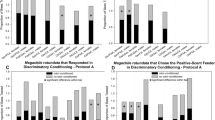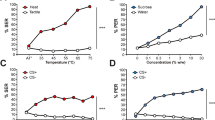Abstract
Individually restrained worker bees were trained to recognize complex odors in a conditioned proboscis extension assay. Three groups of bees were considered, based on the responses recorded during the experimental procedure: selective learners, nonselective learners, and nonlearners. For conditioning, three concentrations of two synthetic mixtures were used. The distribution of bees between groups was not significantly affected by the nature or by the concentration of the conditioning mixture. After conditioning, bees were tested with the individual compounds, and the responses were analyzed with respect to the three groups. Selective learners showed discriminative responses to a few key compounds, while nonselective learners responded to all the compounds, and nonlearners to none. These results showed that complex odor recognition is based on the recognition of key components and relies on the ability of bees to learn.
Similar content being viewed by others
REFERENCES
Bhagavan, S., Benatar, S., Cobey, S., and Smith, B. H. (1994). Effect of genotype but not of age or caste on olfactory learning performance in the honey bee, Apis mellifera. Anim. Behav. 48: 1357–1369.
Bitterman, M. E., Menzel, R., Fietz, A., and Schäfer, S. (1983). Classical conditioning of proboscis extension in honeybees (Apis mellifera). J. Comp. Psychol. 97: 107–119.
Blight, M. M., Hick, A. J., Pickett, J. A., Smart, L. E., Wadhams, L. J., and Woodcock, C. M. (1992). Volatile plant metabolites involved in host plant recognition by the cabbage seed weevil, Ceutorhynchus assimilis. In Menken, S. B. J., Visser, J. H., and Harrewijn, P. (eds.), Proc. 8th Int. Symp. Insect-Plant Relation., Kluwer Academic, Dordrecht, pp. 105–106.
Brandes, C. (1988). Estimation of heritability of learning behavior in honeybees (Apis mellifera capensis). Behav. Genet. 18(1): 119–132.
Breed, M. D., and Julian, G. E. (1992). Do simple rules apply in honey-bee nestmate discrimination? Nature 357: 685–686.
Getz, W. M., and Breed, M. D. (1993). Odour detection in bees. Nature 362: 119–120.
Getz, W. M., and Smith, K. B. (1987). Olfactory sensitivity and discrimination of mixtures in the honeybee Apis mellifera. J. Comp. Physiol. A 160: 239–245.
Getz, W. M., and Smith, K. B. (1990). Odorant moiety and odor mixture perception in free-flying honey bees (Apis mellifera). Chem. Senses 15: 111–128.
Getz, W. M., and Smith, K. B. (1991). Olfactory perception in honeybees: Concatenated and mixed odorant stimuli, concentration, and exposure effects. J. Comp. Physiol. A 169: 215–230.
Getz, W. M., Brückner, D., and Smith, K. B. (1986). Conditioning honeybees to discriminate between heritable odors from full and half sisters. J. Comp. Physiol. A 159: 251–256.
Greggers, U., and Menzel, R. (1993). Memory dynamics and foraging strategies of honeybees. Behav. Ecol. Sociobiol. 32: 17–29.
Koltermann, R. (1969). Lern-und Vergessensprozesse bei der Honigbiene—aufgezeigt anhand von Duftdressuren. Z. Vergl. Physiol. 63(3): 310–334.
Marfaing, P., Rouault, J., and Laffort, P. (1989). Effect of the concentration and nature of olfactory stimuli on the proboscis extension of conditioned honey bees Apis mellifica ligustica. J. Insect Physiol. 35: 949–955.
Mauelshagen, J., and Greggers, U. (1993). Experimental access to associative learning in honeybees. Apidologie 24: 249–266.
Menzel, R., and Bitterman, M. E. (1983). Learning by honeybees in an unnatural situation. In Huber, F., and Markl, H. (eds.), Neuroethology and Behavioral Physiology, Springer-Verlag Berlin Heidelberg, New York, pp. 206–215.
Mesquida, J., Marilleau, R., Pham-Delègue, M.-H., and Renard, M. (1988). A study of rapeseed (Brassica napus L. var. oleifera Metzger) flower nectar secretions. Apidologie 19: 307–318.
Pain, J. (1966). Nouveau modèle de cagettes expérimentales pour le maintien d'abeilles en captivité. Ann. Abeille 9: 71–76.
Pham-Delègue, M.-H., De Jong, R., and Masson, C. (1990). Effect de l'âge sur la réponse conditionnée d'extension du proboscis chez l'abeille domestique. C.R. Acad. Sci. Paris Ser. III 310: 527–532.
Pham-Delègue, M. H., Bailez, O., Blight, M. M., Masson, C., Picard-Nizou, A. I., and Wadhams, L. J. (1993). Behavioural discrimination of oilseed rape volatiles by the honeybee Apis mellifera L. Chem. Senses 18: 483–494.
Ribbands, C. R. (1955). The scent perception of the honeybee. Proc. Roy. Soc. Lond. Ser. B 143: 367–379.
Seeley, T. D. (1982). Adaptive significance of the age polyethism schedule in honeybee colonies. Behav. Ecol. Sociobiol. 11: 287–293.
Smith, B. H. (1991). The olfactory memory of the honeybee Apis mellifera. I. Odorant modulation of short-and intermediate-term memory after single-trial conditioning. J. Exp. Biol. 161: 367–382.
Smith, B. H., and Cobey, S. (1994). The olfactory memory of the honeybee Apis mellifera. II. Blocking between odorants in binary mixtures. J. Exp. Biol. 195: 91–108.
Smith, B. H., and Menzel, R. (1989). The use of electromyogram recordings to quantify odourant discrimination in the honey bee, Apis mellifera. J. Insect Physiol. 35(5): 369–375.
Smith, B. H., Abramson, C. I., and Tobin, T. R. (1991). Conditional withholding of proboscis extension in honeybees (Apis mellifera) during discriminative punishment. J. Comp. Psychol. 105: 345–356.
Sokal, R. R., and Rohlf, F. J. (1981). Biometry, W. H. Freeman, New York.
Tollsten, L., and Bergström, G. (1988). Headspace volatiles of whole plants and macerated plant parts of Brassica and Sinapis. Phytochemistry 27: 4013–4018.
Vareschi, E. (1971). Duftunterscheidung bei der Honigbiene—Einzelzell-Ableitungen und Verhaltensreaktionen. Z. Vergl. Physiol. 75: 143–173.
von Frisch, K. (1967). The Dance Language and Orientation of Bees, Belknap Press of Harvard University Press, Cambridge, MA.
Author information
Authors and Affiliations
Corresponding author
Rights and permissions
About this article
Cite this article
Laloi, D., Roger, B., Blight, M.M. et al. Individual Learning Ability and Complex Odor Recognition in the Honey Bee, Apis mellifera L.. Journal of Insect Behavior 12, 585–597 (1999). https://doi.org/10.1023/A:1020919501871
Issue Date:
DOI: https://doi.org/10.1023/A:1020919501871




